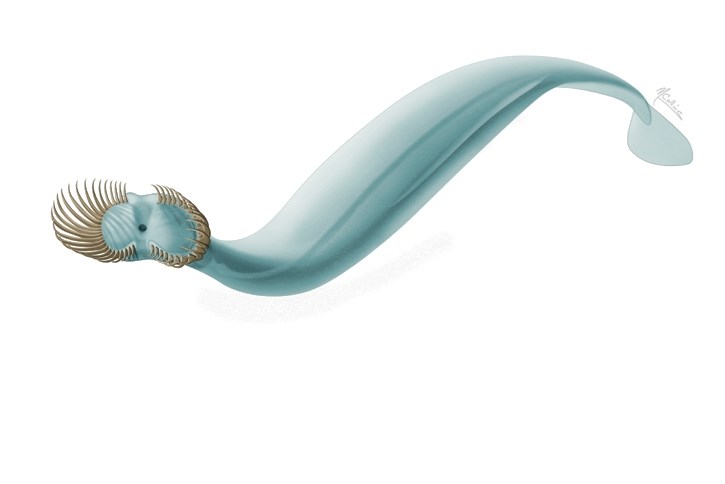The Cambrian Period is known for its unusual creatures, some of which are beautiful and impossibly delicate; others are robust and well-armoured and a few, such as the newest creature to emerge from the fossil record, are the stuff of nightmares.
With its flattened worm-like body and curved grasping spines that surround its mouth, Capinatator praetermissus (Latin for grasping swimmer overlooked) looks like something straight from the imagination of H.R. Giger, the Swiss artist who created the terrifying monster that first appeared in the 1997 movie Alien.
At 10 centimetres in length, while small by today’s standards, 508 million years ago during the Cambrian, according to Derek Briggs and Jean-Bernard Caron writing in the recent issue of the journal Current Biology, Capinatator would have been a monster.
“This new species would have been an efficient predator and a terrifying sight to many of the smallest marine creatures that lived during that time,” said Caron in a release from the Royal Ontario Museum that accompanied the Current Biology study.
But in an evolutionary twist of fate, where Capinatator was once one of the largest predators on Earth, its modern relatives – roughly 120 species of carnivorous worms known as chaetognaths or arrow worms – are now among Earth’s smallest creatures and included among the species that are collectively known as plankton.
As part of their study, Briggs and Caron studied the fossilized remains of 49 Capinatator specimens collected at various Burgess Shale fossil sites in Yoho and Kootenay national parks.
Of those 49 fossilized specimens, six were complete and included preserved soft tissue. The rest of the specimens offered researchers portions of individual worms, including the head with its grasping apparatus and its nightmarish grasping spines.
Briggs and Caron believe that Capinatator fed on smaller Cambrian creatures near the seabed and would have been buried by silt that poured down from the barren, uninhabited landscape.
Chaetognaths, or arrow worms, were first identified among the fossilized creatures of the Burgess Shale formation beginning with Charles Doolittle Walcott who discovered the original site on Fossil Ridge in Yoho National Park over a century ago.
The researchers write that Walcott, however, mistakenly identified Amiskiwia sagittiformas as a chaetognath; Amiskiwia was later identified as a ribbon worm. Another worm that Walcott described as an annelid worm that he named Oesia disjuncta was re-described as a chaetognath. It was later proven – courtesy of new fossils discovered in the Burgess Shale sites – that Oesia was in fact a tube-dwelling enteropneust, also known as an acorn worm.
Simon Conway Morris, the University of Cambridge paleontologist known for his work on the Cambrian fossils and author of 1998’s The Crucible of Creation, found the first evidence of chaetognath grasping spines among fossils Walcott had collected.
A few of the Capinatator specimens used in this study, meanwhile, were collected in the early 1980s during a Royal Ontario Museum expedition that searched for new Burgess Shale sites in the Rockies.
According to Briggs and Caron, the grasping spines are commonly found in Cambrian Period deposits, such as the Burgess Shale, but preserved bodies, on the other hand, are rare.
“These Burgess Shale fossil specimens preserve evidence of features such as the gut and muscles, which normally decay away, as well as the more decay-resistant grasping spines. They show that chaetognath predators evolved during the explosion of marine diversity during the Cambrian Period, and were an important component of some of the earliest marine ecosystems,” said Briggs.
The researchers recognized that Capinatator was a new species and genus by the large number of its grasping spines (about 25 on either side of the grasping apparatus). The number of spines in living species ranges from three to 14, while fossilized chaetognath specimens from China have roughly six and eight spines on either side of the apparatus.
Capinatator is one of a long list of new species and new creatures discovered and re-described among the fossils of the Burgess Shale as new sites, new research of previously collected fossils and new techniques have allowed researchers such as Briggs and Caron take a deeper look at the creatures of the Burgess Shale.




